Polaris®KA SM05-Threaded Mounts for Ø1/2" Optics

- SM05-Threaded Mounting Bore
- Matched Actuator and Back Plate Threading Minimize Drift and Backlash
- Minimal Temperature-Dependent Hysteresis
- Lightweight Aluminum Front and Back Plates
KA05T
2 Adjusters with Side Holes
KA05TA
3 Adjusters with Side Holes
KA05TB
2 Low-Profile Adjusters
LN19100H
3/16"-100 Adjuster Lock Nut
Application Idea
KA05T Ø1/2" Mirror Mount with Mirror
on a Ø1/2" Post for Polaris Mounts

Please Wait
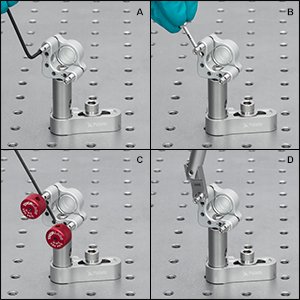
Click to Enlarge
Figure 1.1 Methods of Adjusting the KA05T Ø1/2" Mount:
A: 5/64" or 2.0 mm Hex Key in the End of the Adjuster
B: SA1 Tool Through Adjuster Side Holes
C: HKTS-5/64 Hex Knobs with 1/16" or 1.5 mm Balldriver Through Side Holes for Fine Adjustment
D: TW6 Torque Wrench Used to Secure LN19100H Lock Nut
| Quick Links |
|---|
| Ø1/2" Mount with 3 Adjusters |
| Ø1/2" Mounts with 2 Adjusters |
| Hex Adjusters |
| Side Hole Adjustment Tool |
| Lock Nut & Torque Wrench |
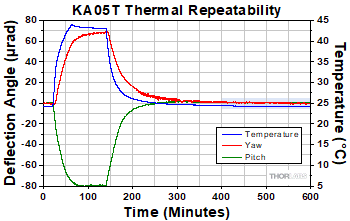
Click to Enlarge
Figure 1.2 Each PolarisKA mount undergoes extensive thermal testing to ensure high-quality performance. Please see the Test Data tab for additional test results.
Features
- Machined from Aged 7075 Aluminum Alloy for Exceptional Tensile Strength, Stiffness, Surface Toughness, and Dimensional Stability
- Hardened Stainless Steel Ball Contacts with Sapphire Seats for Durability and Smooth Movement
- Matched Actuator and Back Plate Provide Stability and Smooth Kinematic Adjustment
- Extensive Testing Guarantees Less than 4 μrad Deviation after 15°C Temperature Cycling (See Test Data Tab for Details)
- Specialty Anodized Frames and Passivated Stainless Steel Adjusters Designed for Vacuum and High-Power Laser Cavity Applications
- Patent Pending Spring Design Reduces Contamination
- Mounting Holes Enable Left-Handed or Right-Handed Operation
- Custom Mount Configurations are Available by Contacting Tech Sales
Polaris®KA Low-Drift Kinematic Mirror Mounts feature low-drift design considerations and clear-anodized 7075 aluminum construction, making them ideal for industrial applications requiring stringent long-term alignment stability.
Optic Retention
These Ø1/2" mirror mounts feature an SM05-threaded (0.535"-40) bore that allows a variety of optical components to be secured in the mount. Two clear anodized, aluminum retaining rings are included with each mount; additional retaining rings can also be purchased separately.
Polaris optic bores are precision machined to achieve a fit that will provide optimal beam pointing stability over changing environmental conditions such as temperature changes, transportation shock, and vibration. Performance will be diminished if these mounts are used with optics that have an outer diameter tolerance greater than zero or smaller metric optic sizes (Ø12.5 mm).
Design
Machined from aged, lightweight 7075 aluminum alloy, PolarisKA mounts utilize precision-matched adjusters with ball contacts and sapphire seats to provide smooth kinematic adjustment. As shown on the Test Data tab, these mounts have undergone extensive testing to ensure high-quality performance. The Polaris design addresses all of the common causes of beam misalignment; please refer to the Design Features tab for detailed information.
Post Mounting
These PolarisKA mirror mounts are equipped with #8 (M4) counterbores for post mounting. See the Usage Tips tab for more recommendations about mounting configurations.
Cleanroom and Vacuum Compatibility
All of our PolarisKA mounts are designed to be compatible with cleanroom and vacuum applications and have maximum bake-out and operating temperatures of 80°C. See the Specs tab and the Design Features tab for details.
The aluminum front and back plates of PolarisKA mounts are acid etched, specialty anodized with a thin 5 µm oxide layer, and duplex sealed with nickel, followed by boiling in reverse osmosis deionized (RODI) water. This process creates an all-metal surface that is clean, smooth, thin, hard, non-porous, and has a sealed oxide layer. This same surface treatment is also used by some vacuum chamber manufacturers to prevent a native oxide layer from forming on the surface of bare aluminum. This surface finish provides an improvement over standard anodizing. For PolarisKA mounts, we recommend a maximum bake-out temperature of no more than 80°C. For additional details, refer to the Specs tab.
To further reduce outgassing rates in ultra-high vacuum (UHV) systems, we can provide mounts upon request with bare aluminum parts that are only acid etched; please contact Tech Sales with inquiries. Due to the reduction in surface hardness, these mounts will not have the same surface toughness, resulting in faster wear on the lens cells and adjuster screw threads. Such mounts would also need to be carefully handled and stored to prevent surface contamination and the formation of a native oxide layer. These custom mounts would support a maximum bake-out temperature of no more than 200°C.
For the lowest outgassing rates in UHV systems, please consider the stainless steel Polaris line, which support a maximum bake-out temperature of no more than 200°C.
| Item # | KA05TA | KA05T | KA05TB |
|---|---|---|---|
| Optic Sizea | Ø1/2" | ||
| Optic Thickness (Max) | 0.25" (6.4 mm) | ||
| Number of Adjusters | Three | Two | Two, Low Profile |
| Adjuster Drive | 5/64" (2.0 mm) Hex, Ø0.07" Side Adjustment Holes | 5/64" (2.0 mm) Hex | |
| Adjuster Thread | 3/16"-100 | ||
| Actuator Matching | Matched Actuator/Body Pairs | ||
| Measured Point-to-Point Mechanical Resolution per Adjuster |
5 µrad (Typical); 2 µrad (Achievable) |
||
| Adjustment Resolutionb | ~14.3 mrad/rev | ||
| Mechanical Angular Range (Nominal) | ±4° | ||
| Front Plate Separation at Pivot Adjuster | 1.5 mm (Nominal) | ||
| Front Plate Translation (Max) | 5 mm | N/A | |
| Beam Deviationc After Thermal Cycling | <4 μrad | ||
| Recommended Optic Mounting Torqued | 6 - 20 oz-in for 6 mm Thick UVFS Optics | ||
| Maximum SM-Threaded Component Mounting Torque | 15 lb-in for SM05-Threaded Parts | ||
| Maximum Front Plate Payload (Torque / Weight) from Mounted Components | 1 lb-in (0.11 N·m) / 1 lb (4.5 N) | ||
| Mounting | Two #8 (M4) Counterbores at 90° | ||
| Cleaninge | Adjuster screws are passivated per ASTM-967; Frames are acid etched, anodized to MIL-A-8625, Type 2, Class 1, with a thin dense oxide layer and duplex sealed using nickel followed by boiling in reverse osmosis deionized (RODI) water. |
||
| Vacuum Compatibilityf | 10-9 Torr at 25 °C with Proper Bake Out 10-5 Torr at 25 °C without Bake Out Grease Vapor Pressure: 10-13 Torr at 20 °C; 10-5 Torr at 200 °C Epoxy Meets Low Outgassing Standards NASA ASTM E595, Telcordia GR-1221 |
||
| Mass (Weight) | 19 g (0.7 oz) | 17 g (0.6 oz) | 15 g (0.5 oz) |
| Operating Temperature Range | -30 to 80 °C | ||
Polaris®KA Mirror Mount Test Data
All Polaris Low-Drift Kinematic Mirror Mounts undergo extensive testing to ensure high-quality performance. Thermal shock testing confirms the exceptional stability of the mounts and demonstrates that they reliably return to their initial position after a transient temperature shift. Interferometric wavefront distortion testing demonstrates the ability of Polaris mounts to secure an optic without significantly distorting the optical surface.
Video 3.1 Vibration Testing for Polaris Mounts (Ø19 mm Polaris Mount Shown)
Vibration Testing
Purpose: This testing was done to determine how reliably PolarisKA mirror mounts behave when subjected to intense physical vibrations.
Procedure: A pair of identical KA05 mirror mounts were mounted on Ø1" Posts for Polaris Mirror Mounts and secured to a stainless steel breadboard with POLARIS-CA1 clamping arms. Laser beams were reflected from the mirrors onto two position sensing detectors, located on the same breadboard. The entire platform was vibrated with a variable frequency and amplitude, and the displacement of the beam on the detector was recorded. The two beam paths were oriented at right angles so that the vibrational motion was in a direction parallel to the face of one mount and perpendicular to the face of the other. Please see Video 3.1 for a demonstration of our Polaris vibration test (the mount shown in the video is the POLARIS-K19S4 Ø19 mm mount).
Results: When subjected to vibrational frequencies from 5 to 500 Hz and accelerations as high as 6 g, the KA05 mounts remained mechanically sound. The angular position of the mounts remained stable within about 10 µrad for both parallel and perpendicular vibrations.
Conclusions: Our PolarisKA mirror mounts provide exceptional performance, even under rugged operating conditions. As a result, these mounts are ideal for use in systems that require the greatest degree of stability when vibrational noise is expected.
Positional Repeatability After Thermal Shock
Purpose: This testing was done to determine how reliably the mount returns the mirror, without hysteresis, to its initial position. These measurements show that the alignment of the optical system is unaffected by the temperature shock.
Procedure: After attaching the PolarisKA mount to a Ø1" Post, the mirror and post assembly was secured to a stainless steel optical table in a temperature-controlled environment. The mirror was held using the flexure mechanism; see the Usage Tips tab for additional mounting considerations. A beam from an independently temperature-stabilized laser diode was reflected by the mirror onto a position sensing detector. The temperature of each mirror mount tested was raised to at least 37 °C. The elevated temperature was maintained in order to soak the mount at a constant temperature. Then the temperature of the mirror mount was returned to the starting temperature. The results of these tests are shown in Tables 3.2, 3.5, and 3.8.
Results: As can be seen in these plots, when the mount was returned to its initial temperature, the angular position (both pitch and yaw) of the mirrors returned to within 4 µrad of its initial position. The performance of the mount was tested further by subjecting the mount to repeated temperature change cycles. After each cycle, the mirror's position reliably returned to within 4 µrad of its initial position.
For Comparison: To get a 4 µrad change in the mount’s position, the 3/16"-100 threaded adjuster on the PolarisKA mount needs to be rotated by only 0.1° (1/3600 of a turn). A highly skilled operator might be able to make an adjustment as small as 0.3° (1/1200 of a turn), which corresponds to a 12 µrad change in the mount's position.
Conclusions: PolarisKA Mirror Mounts are high-quality, ultra-stable mounts that will reliably return a mirror to its original position after cycling through a temperature change. As a result, PolarisKA mounts are ideal for use in applications that require long-term alignment stability.
| Table 3.2 KA05TA 3-Adjuster Mount with Adjuster Side Holes, SM05 Threaded |
|---|
| Table 3.5 KA05T 2-Adjuster Mount with Adjuster Side Holes, SM05 Threaded |
|---|
| Table 3.8 KA05TB 2-Adjuster Mount with Low-Profile Adjusters, SM05 Threaded |
|---|
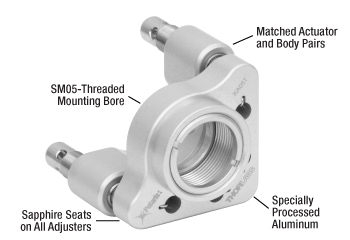
Click to Enlarge
Figure 4.1 Design Features of KA05T Series Mounts
Several common factors typically lead to beam misalignment in an optical setup. These include temperature-induced hysteresis of the mirror's position, crosstalk, drift, and backlash. Polaris mirror mounts are designed specifically to minimize these misalignment factors and thus provide extremely stable performance. Hours of extensive research, multiple design efforts using sophisticated design tools, and months of rigorous testing went into choosing the best components to provide an ideal solution for experiments requiring ultra-stable performance from a kinematic mirror mount.
Thermal Hysteresis
The temperature in most labs is not constant due to factors such as air conditioning, the number of people in the room, and the operating states of equipment. Thus, it is necessary that all mounts used in an alignment-sensitive optical setup be designed to minimize any thermally induced alignment effects. All the critical components of the PolarisKA series mirror mounts are made from specially selected dimensionally stable materials, such as low stress aged round 7075 aluminum bar stock to reduce internal stresses that can cause temperature-dependent hysteresis and optimal material tempers to improve the material stiffness and strength. As a result, the alignment of the optical system will be restored when the temperature of the mirror mount is returned to the initial temperature.
The method by which the mirror is secured in the mount is another important design factor for PolarisKA series mounts; these mounts offer excellent performance without the use of adhesives. Instead, the mounts offered on this page use a monolithic flexure arm that is pressed onto the edge of the mirror using a setscrew. Setscrews, when used by themselves to hold an optic, tend to move as the temperature changes. In contrast, the holding force provided by the aluminum flexure arm is sufficient to keep the mirror locked into place regardless of the ambient temperature.
Crosstalk
Crosstalk is minimized by carefully controlling the dimensional tolerances of the front and back plates of the mount so that the pitch and yaw actuators are orthogonal. In addition, sapphire seats are used at all three contact points. Standard metal-to-metal actuator contact points will wear down over time. The polished sapphire seats of PolarisKA series mounts, in conjunction with the hardened stainless steel actuator tips, maintain the integrity of the contact surfaces over time.
Drift and Backlash
In order to minimize the positional drift of the mirror mount and backlash, it is necessary to limit the amount of play in the adjuster as well as the amount of lubricant used. When an adjustment is made to the actuator, the lubricant will be squeezed out of some spaces and built up in others. This non-equilibrium distribution of lubricant will slowly relax back into an equilibrium state. However, in doing so, this may cause the position of the front plate of the mount to move. PolarisKA series mounts use adjusters matched to the body or bushings that exceed all industry standards so very little adjuster lubricant is needed. As a result, alignment of these mounts is extremely stable even after being adjusted (see the Test Data tab for more information). In addition, these adjusters have a smooth feel that allows the user to make small, repeatable adjustments.
Cleanroom and Vacuum Compatibility
The front and back plates of PolarisKA mounts are machined from aged 7075 aluminum alloy for exceptional tensile strength, stiffness, surface toughness, and dimensional stability. They are then acid etched, specialty anodized with a thin 5 µm oxide layer, and duplex sealed with nickel, followed by boiling in reverse osmosis deionized (RODI) water. This process creates an all-metal surface that is clean, smooth, thin, hard, non-porous, and has a sealed oxide layer that supports use in low outgassing laser systems and cleanroom assembled systems. This same surface treatment is also used by some vacuum chamber manufacturers to prevent a native oxide layer from forming on the surface of bare aluminum. This surface finish provides an improvement over standard anodizing. For PolarisKA series mounts, we recommend a maximum bake-out temperature of no more than 80 °C.
To further reduce outgassing rates in ultra-high vacuum (UHV) systems, we can provide mounts upon request with bare aluminum parts that are only acid etched; please contact Tech Sales with inquiries. Due to the reduction in surface hardness, these mounts will not have the same surface toughness as the fully processed mounts, resulting in faster wear on the lens cells and adjuster screw threads. Such mounts would also need to be carefully handled and stored to prevent surface contamination and the formation of a native oxide layer. These custom mounts would support a maximum bake-out temperature of no more than 200 °C.
For the lowest outgassing rates in UHV systems, please consider the stainless steel Polaris products which support a maximum bake-out temperature of no more than 200 °C.
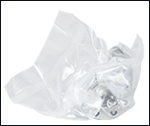
Click to Enlarge
Figure 4.2 All PolarisKA mounts are shipped inside two vacuum bag layers.
The sapphire contacts are bonded into place using a NASA-approved low outgassing procedure. In addition, DuPont LVP High-Vacuum (Krytox) Grease, an ultra-high vacuum compatible, low outgassing PTFE grease, is applied to the adjusters. These features provide high vacuum compatibility and low outgassing performance. When operating at pressures below 10-5 Torr, we highly recommend using an appropriate bake out procedure prior to installing the mount in order to minimize contamination caused by outgassing. Please note that the 8-32 and M4 cap screws included with the Polaris mounts are not rated for pressures below 10-5 Torr.
Cleanroom-Compatible Packaging
Each vacuum-compatible Polaris mount is packaged within two vacuum bag layers after assembly in a clean environment, as seen in Figure 4.2. The vacuum-tight fit of the bags stabilizes the mount, limiting translation of the front plate due to shocks during transportation. The tight fit also minimizes rubbing against the bag, preventing the introduction of bag material shavings that would contaminate the clean mount.
In the vacuum-sealing process, moisture-containing air is drawn out of the packaging. This eliminates unwanted reactions on the surface of the mount without the need for desiccant materials. The vacuum bags protect the mount from contamination by air or dust during transport and storage, and the double-vacuum bag configuration allows for a straightforward and effective cleanroom entry procedure. The outer bag can be removed outside of the cleanroom, allowing the contaminant-free inner bag to be placed into a clean container and transferred into the cleanroom while retaining the benefits of vacuum-bag packaging. Inside the cleanroom, the mount can be removed from the inner bag when ready for use.
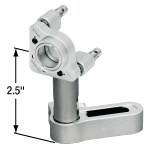
Click to Enlarge
Figure 5.1 These mounts can be mounted to a surface using a Ø1/2" Post and a clamping arm designed for Polaris mounts. Using a 2" long post, the optical axis is 2.5" above the table surface.
Through thermal changes and vibrations, Polaris®KA kinematic mirror mounts are designed to provide years of use. Below are some usage tips to ensure that the mount provides optimal performance.
Mounting Guidelines
When installing PolarisKA mounts, we recommend using Ø1/2" or Ø1" posts and a clamping arm designed for Polaris mounts. If not available, we recommend mounting to aluminum components.
Use a Wide Post
The performance of these mounts is optimized for use with our posts and clamping arms designed for Polaris mounts. These posts are made of stainless steel and provide two lines of contact with the mount, which help confine the bottom of the mount during variations in the surrounding temperature, thereby minimizing potential alignment issues.
Optic Mounting
Since an optic is prone to movement within its mounting bore, all optics should be mounted with the mount out of the setup to ensure accurate mounting that will minimize misalignment effects. We recommend using a TD24 torque wrench with an SPB05 spanner bit for SM05-threaded optic mounts, respectively. See the Specs tab for recommended torques. Over torquing the optic retaining rings can result in dramatic surface distortions.
Front Plate’s Position
The mounts sold on this page are designed to allow adjustments of up to 8°. To achieve the best performance, it is recommended that the front plate be kept as parallel as possible to the back plate. This ensures the highest stability of the adjustments.
Mount as Close to the Table’s Surface as Possible
To minimize the impact of vibrations and temperature changes, it is recommended that your setup has as low of a profile as possible. Using short posts will reduce the Y-axis translation caused by temperature variations and will minimize any movements caused by vibrations. The mount can also be secured directly to an optical table or breadboard using a 1/4"-20 to 8-32 thread adapter (Item # AE8E25E) or M6 x 1.0 to M4 x 0.7 thread adapter (Item # AE4M6M). By doing so, the instability introduced by a post will be eliminated. These mounts would perform best when mounted directly to an aluminum base plate.
Polish and Clean the Points of Contact
We highly recommend that the points of contact between the mount and the post, as well as the post and the table, are clean and free of scratches or defects. For best results, we recommend using a polishing stone to clean the table’s surface and an LF1P polishing pad for the top and bottom of the post as well as the bottom of the mount.
Use Polaris-Specific Adjustment Tools
The SA1 Adjustment Tool features a precision fit tip that is designed for the 0.07" side-hole adjusters used in the KA05TA and KA0T5 mounts. Additionally, its handle includes a 5/64" (2.0 mm) hex that is compatible with the hex on the end of each adjuster screw. For KA05TA and KA05T mounts that are exposed to shock and vibration, Thorlabs offers the LN19100H 3/100"-100 Lock Nut. In situations where frequent adjustment is required, the LN19100H lock nut can be hand-tightened with a torque of 4 to 8 oz-in (0.03 to 0.06 N•m). If long-term stability is required, the TW6 Torque Wrench can be used to tighten the lock nuts with 25 oz-in of torque.
Not Recommended
We do not recommend taking the adjusters out of the back plate, as it can contaminate the threading. This can reduce the fine adjustment performance significantly. Also, do not pull the front plate away as it might stretch the springs beyond their operating range or crack the sapphire seats. Finally, do not over tighten the retaining screws that secure the flat spring that holds the optic in place; only slight force is required to secure the optic in place.
| SM05 Threading: Ø1/2" Lens Tubes, 16 mm Cage Systems | |||
|---|---|---|---|
| External Thread, 0.535"-40.0 UNS-2A | Internal Thread, 0.535"-40.0 UNS-2B | ||
| Max Major Diameter | 0.5340" | Min Major Diameter | 0.5350" |
| Min Major Diameter | 0.5289" | Min Pitch Diameter | 0.5188" |
| Max Pitch Diameter | 0.5178" | Max Pitch Diameter | 0.5230" |
| Min Pitch Diameter | 0.5146" | Min Minor Diameter (and 83.3% of Thread) | 0.508" |
| Max Minor Diameter | 0.5069" | Max Minor Diameter (and 64.9% of Thread) | 0.514" |
| RMS Threading: Objective, Scan, and Tube Lenses | |||
|---|---|---|---|
| External Thread, 0.800"-36.0 UNS-2A | Internal Thread, 0.800"-36.0 UNS-2B | ||
| Max Major Diameter | 0.7989" | Min Major Diameter | 0.8000" |
| Min Major Diameter | 0.7934" | Min Pitch Diameter | 0.7820" |
| Max Pitch Diameter | 0.7809" | Max Pitch Diameter | 0.7866" |
| Min Pitch Diameter | 0.7774" | Min Minor Diameter (and 83.3% of Thread) | 0.770" |
| Max Minor Diameter | 0.7688" | Max Minor Diameter (and 64.9% of Thread) | 0.777" |
| C-Mount Threading: Machine Vision Lenses, CCD/CMOS Cameras | |||
|---|---|---|---|
| External Thread, 1.000"-32.0 UN-2A | Internal Thread, 1.000"-32.0 UN-2B | ||
| Max Major Diameter | 0.9989" | Min Major Diameter | 1.0000" |
| Min Major Diameter | 0.9929" | Min Pitch Diameter | 0.9797" |
| Max Pitch Diameter | 0.9786" | Max Pitch Diameter | 0.9846" |
| Min Pitch Diameter | 0.9748" | Min Minor Diameter (and 83.3% of Thread) | 0.966" |
| Max Minor Diameter | 0.9651" | Max Minor Diameter (and 64.9% of Thread) | 0.974" |
| SM1 Threading: Ø1" Lens Tubes, 30 mm Cage Systems | |||
|---|---|---|---|
| External Thread, 1.035"-40.0 UNS-2A | Internal Thread, 1.035"-40.0 UNS-2B | ||
| Max Major Diameter | 1.0339" | Min Major Diameter | 1.0350" |
| Min Major Diameter | 1.0288" | Min Pitch Diameter | 1.0188" |
| Max Pitch Diameter | 1.0177" | Max Pitch Diameter | 1.0234" |
| Min Pitch Diameter | 1.0142" | Min Minor Diameter (and 83.3% of Thread) | 1.008" |
| Max Minor Diameter | 1.0068" | Max Minor Diameter (and 64.9% of Thread) | 1.014" |
| SM30 Threading: Ø30 mm Lens Tubes | |||
|---|---|---|---|
| External Thread, M30.5 x 0.5 – 6H/6g | Internal Thread, M30.5 x 0.5 – 6H/6g | ||
| Max Major Diameter | 30.480 mm | Min Major Diameter | 30.500 mm |
| Min Major Diameter | 30.371 mm | Min Pitch Diameter | 30.175 mm |
| Max Pitch Diameter | 30.155 mm | Max Pitch Diameter | 30.302 mm |
| Min Pitch Diameter | 30.059 mm | Min Minor Diameter (and 83.3% of Thread) | 29.959 mm |
| Max Minor Diameter | 29.938 mm | Max Minor Diameter (and 64.9% of Thread) | 30.094 mm |
| SM1.5 Threading: Ø1.5" Lens Tubes | |||
|---|---|---|---|
| External Thread, 1.535"-40 UNS-2A | Internal Thread, 1.535"-40 UNS-2B | ||
| Max Major Diameter | 1.5339" | Min Major Diameter | 1.535" |
| Min Major Diameter | 1.5288" | Min Pitch Diameter | 1.5188" |
| Max Pitch Diameter | 1.5177" | Max Pitch Diameter | 1.5236" |
| Min Pitch Diameter | 1.5140" | Min Minor Diameter (and 83.3% of Thread) | 1.508" |
| Max Minor Diameter | 1.5068" | Max Minor Diameter (and 64.9% of Thread) | 1.514" |
| SM2 Threading: Ø2" Lens Tubes, 60 mm Cage Systems | |||
|---|---|---|---|
| External Thread, 2.035"-40.0 UNS-2A | Internal Thread, 2.035"-40.0 UNS-2B | ||
| Max Major Diameter | 2.0338" | Min Major Diameter | 2.0350" |
| Min Major Diameter | 2.0287" | Min Pitch Diameter | 2.0188" |
| Max Pitch Diameter | 2.0176" | Max Pitch Diameter | 2.0239" |
| Min Pitch Diameter | 2.0137" | Min Minor Diameter (and 83.3% of Thread) | 2.008" |
| Max Minor Diameter | 2.0067" | Max Minor Diameter (and 64.9% of Thread) | 2.014" |
| SM3 Threading: Ø3" Lens Tubes | |||
|---|---|---|---|
| External Thread, 3.035"-40.0 UNS-2A | Internal Thread, 3.035"-40.0 UNS-2B | ||
| Max Major Diameter | 3.0337" | Min Major Diameter | 3.0350" |
| Min Major Diameter | 3.0286" | Min Pitch Diameter | 3.0188" |
| Max Pitch Diameter | 3.0175" | Max Pitch Diameter | 3.0242" |
| Min Pitch Diameter | 3.0133" | Min Minor Diameter (and 83.3% of Thread) | 3.008" |
| Max Minor Diameter | 3.0066" | Max Minor Diameter (and 64.9% of Thread) | 3.014" |
| SM4 Threading: Ø4" Lens Tubes | |||
|---|---|---|---|
| External Thread, 4.035"-40 UNS-2A | Internal Thread, 4.035"-40.0 UNS-2B | ||
| Max Major Diameter | 4.0337" | Min Major Diameter | 4.0350" |
| Min Major Diameter | 4.0286" | Min Pitch Diameter | 4.0188" |
| Max Pitch Diameter | 4.0175" | Max Pitch Diameter | 4.0245" |
| Min Pitch Diameter | 4.0131" | Min Minor Diameter (and 83.3% of Thread) | 4.008" |
| Max Minor Diameter | 4.0066" | Max Minor Diameter (and 64.9% of Thread) | 4.014" |
| Posted Comments: | |
| No Comments Posted |

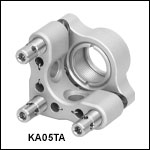
Click to Enlarge
Figure G1.1 KA05TA Mount Features 3 Adjusters with Side Holes
- 3 Hex Adjusters with Side Holes
- Designed for use with Ø1/2" Optics
- 3/16"-100 Threaded Matched Actuator/Body Pairs
- ±4° Mechanical Angular Range (Nominal)
- ~14.3 mrad/rev Resolution
- Less than 4 µrad Deviation after Temperature Cycling (See the Test Data Tab for Details)
- Patent Pending Spring Design Reduces Contamination
The KA05TA 3-Adjuster Ø1/2" PolarisKA Kinematic Mirror Mount is designed to provide easy, high-resolution adjustment and the long-term alignment stability needed in industrial applications. It features an SM05-threaded (0.535"-40) bore for mounting Ø1/2" optics up to 0.25" (6.4 mm) thick or SM05-threaded components. The three-adjuster design provides tip and tilt plus Z-axis (optical axis) adjustment. Two-adjuster versions are also available below.
The 3/16"-100 threaded adjusters feature two Ø0.07" (Ø1.8 mm) through holes that allow for actuation from the side using our precision-fit SA1 Side Hole Adjustment Tool (sold below) or a 1/16" (1.5 mm) balldriver or hex key. Each adjuster also has a 5/64" (2.0 mm) hex and may be adjusted with the hex on the end of the SA1, our HKTS-5/64 Hex Key Thumbscrews (sold below), or any other 5/64" (2.0 mm) hex wrench. The adjusters on this mount can be locked using LN19100H lock nuts (sold below). For applications that require frequent tuning of the adjusters, the lock nuts only need to be lightly tightened to a torque of approximately 4 to 8 oz-in (0.03 to 0.06 N·m). For long term stability, we recommend tightening to a torque of 24 oz-in, which can be achieved by using our TW6 preset torque wrench (sold below).
Two clear-anodized aluminum retaining rings (included) are used to hold the mounted optic. Additional retaining rings (Item # SM05KRR) can also be purchased separately. Post mounting is provided by two #8 (M4) counterbores at 90°. We recommend using this mount with a stainless steel Ø1/2" or Ø1" Post for Polaris mounts.
NOTE: These mounts are designed for Ø1/2" optics and are not intended for use with the Ø12.5 mm metric mirror size.

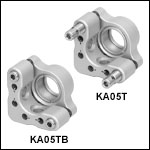
Click to Enlarge
Figure G2.1 KA05T Mount Features 2 Adjusters with Side Holes and KA05TB Features 2 Low-Profile, Hex-Driven Adjusters
- 2 Side-Hole or Low-Profile Hex Adjusters
- Designed for use with Ø1/2" Optics
- 3/16"-100 Threaded Matched Actuator/Body Pairs
- ±4° Mechanical Angular Range (Nominal)
- ~14.3 mrad/rev Resolution
- Less than 4 µrad Deviation after Temperature Cycling (See the Test Data Tab for Details)
- Patent Pending Spring Design Reduces Contamination
The KA05T and KA05TB 2-Adjuster SM05-Threaded Ø1/2" PolarisKA Kinematic Mirror Mounts are similar to the standard 3-adjuster version sold above but feature a hardened steel ball in place of the third adjuster. The 2-adjuster design improves mount stability by limiting the available degrees of freedom for movement, making these mounts ideal solutions for OEM applications that require reliable operation in rugged environments. Each mount features an SM05-threaded (0.535"-40) bore for mounting Ø1/2" optics up to 0.25" (6.4 mm) thick or SM05-threaded components.
For fitting into tight spaces, the KA05TB mount is equipped with low-profile hex adjusters that are 0.33" (8.4 mm) shorter than the adjusters on the KA05T; due to the shorter adjusters, the KA05TB mount cannot be used with LN19100H lock nuts. The hex actuators are compatible with 5/64" (2.0 mm) hex keys and may be adjusted with our HKTS-5/64 Hex Key Thumbscrew (sold below) or any other 5/64" (2.0 mm) hex wrench.
The KA05T mount has standard-profile hex adjusters with Ø0.07" (Ø1.8 mm) through holes that allow for actuation from the side using our precision-fit SA1 Side Hole Adjustment Tool (sold below) or a 1/16" (1.5 mm) balldriver or hex key. Each adjuster also has a 5/64" (2.0 mm) hex and may be adjusted with the hex on the end of the SA1, our HKTS-5/64 Hex Key Thumbscrews (sold below), or any other 5/64" (2.0 mm) hex wrench. The adjusters on this mount can be locked using LN19100H lock nuts (sold below). For applications that require frequent tuning of the adjusters, the lock nuts only need to be lightly tightened to a torque of approximately 4 to 8 oz-in (0.03 to 0.06 N·m). For long term stability, we recommend tightening to a torque of 24 oz-in, which can be achieved by using our TW6 preset torque wrench (sold below).
Two clear-anodized aluminum retaining rings (included) are used to hold the mounted optic. Additional retaining rings (Item # SM05KRR) can also be purchased separately. Post mounting is provided by two #8 (M4) counterbores at 90°. We recommend using these mounts with stainless steel Ø1/2" or Ø1" Posts for Polaris mounts.
NOTE: These mounts are designed for Ø1/2" optics and are not intended for use with the Ø12.5 mm metric mirror size.

- 2 mm(5/64インチ)の六角レンチを使用するアクチュエータの調整に便利
- 赤色アルマイト加工の調整ノブで六角レンチのサイズが刻印
- 六角チップは取り替え可能
- 1パック4個入り
この2 mm(5/64インチ)六角レンチ型の調整用つまみネジを使用することで、2 mm六角レンチで調整するアクチュエータ(またはノブを取り外した標準タイプのアクチュエータ)が迅速に調整できます。 これは取り外し可能なノブであるため、調整の合間にネジの六角穴に取り付けたままにしておくことができて便利です(Figure 206A参照)。 #8-32止めネジ(2 mm六角)が取り替え可能の六角形のビットを固定します。この取り替え可能なビットは、一方の先端がつぶれてしまっても、逆向きで再利用できます。 交換用の六角レンチ型ビットが必要な場合には、当社にお問い合わせください。
つまみネジ型六角レンチには、0.050~3/16インチと2 mm~5 mmのサイズの製品があります。

- Polarisアジャスタのサイドホールに精密にフィットするØ1.7 mmの先端
- ハンドル部分に2.0 mm六角レンチ
- 化学洗浄済みで、磁性のあるステンレススチール製
サイドホール調整ツールには、Polarisマウントのサイドホールアジャスタに精密にフィットするように設計されたØ1.7 mmの先端があります。ハンドルには2.0 mm六角レンチがついており、SA1を小さなつまみのように使用することができます。また中央のナットには6.0 mmレンチが取付け可能なため、長めのレバーアームを構成することもできます。精密な先端は調整時のバックラッシュが小さく、また深さストッパにより調整中のツールをサイドホール内にしっかり固定しておくことができます。Ø25 mmよりも大きいミラーマウントに対しては、ツールの長さが41.2 mmであるため、マウント背面にあるほかのアジャスタと干渉せずにアクチュエータを360°調整できます。
SA1は化学洗浄と硬化処理を施されたステンレススチール製で、耐久性があるうえにクリーンな環境にも対応します。磁性があるため、スペースのない、あるいは振動に敏感なセットアップでは磁石を使用してツールを回収することができます。

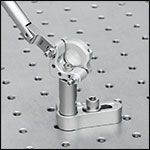
Click to Enlarge
Figure 773B トルクレンチTW6を使用して、ミラーマウントKA05シリーズのアジャスタを止めナットLN19100Hで固定

Click to Enlarge
Figure 773A トルクレンチTW6には型番とプリセットされたトルク値が刻印されています。
- 3/16"-100アルミニウム製止めナットLN19100Hでアジャスタの長期安定性を確保
- 長期的に固定するのに適したトルクレンチTW6
- プリセット値:0.17 N·m
- 適切なトルクを確実に負荷できるブレークオーバー(Break-Over)型
止めナットLN19100Hは、3/16"-100アジャスタ付きのPolaris KAシリーズマウントを、長期安定性が要求される用途や、衝撃や振動にさらされるセットアップでも使用できるようにするために設計されています。なお、この止めナットは薄型アジャスタには使用しないでください。KA05シリーズマウントと同じアルミニウム合金製で、製造方法も同じです(詳細は「仕様」タブをご覧ください)。
アジャスタをたびたび調整しなければならない場合には、止めナットは手でおよそ0.03~0.06 N·mのトルクで軽く締め付けるだけで十分です。長期的な安定性が求められる場合には、トルクレンチTW6(Table G4.3参照)を使用して各止めナットを0.17 N·mのトルクで締め付けることができます。止めナット取付け時のクロススレッド(斜めにねじ込む状態)を防ぐために、まず止めナットをアジャスタに当ててネジが緩む方向に回し、かすかなネジの段差の感触でネジが整合したことを確認してからネジを締めるようにしてください。
プリセット型トルクレンチ
このトルクレンチには、Polarisマウントのアジャスタを、6 mm止めナットで長期的に固定するうえで適切なトルク値がプリセットされています。仕様についてはTable 773Cをご覧ください。プリセットされたトルク値に達すると、Figure 773Bのようにピボットジョイントが折れ曲がるように設計されています。力を抜くと、レンチの六角ヘッドは元の位置に戻ります。この設計により、止めナットに設定値以上のトルクが加わるのを防止しています。指標として刻印されている線は、定められたトルクをかけるためにレンチを回転させる角度を示しています。この線を越えてハンドルを回転させると、止めナットを締め付けすぎていることになります。レンチには、使用時に識別しやすいように、プリセットのトルク値、トルクをかける方向、レンチサイズ、および型番が刻印されています。
このレンチは、クリーンルームや真空チャンバ内でも使用可能です。Carpenter AAA不動態化処理による化学洗浄を行い、表面から硫黄、鉄、汚染物質などを除去しています。不動態化処理の後は、クリーンな(汚染されていない)環境下で組み立て、2重の真空バッグに入れてクリーンルームに搬入するまでの間に汚染されないようにしています。また、レンチはビードブラスト加工されており、レーザが使用されているセットアップで作業するときに、反射光が最小限に抑えられるようになっています。
なお、このレンチはアジャスタを高頻度で調整するためのものではありません(そのような用途で必要とされるトルク値は、通常0.03~0.06 N·mです)。
| Table 773C Specifications | ||||
|---|---|---|---|---|
| Item # | Torque | Torque Accuracy | Hex | Compatible Items |
| TW6 | 24 oz-in (0.17 N•m) | ±1.44 oz-in (0.010 N•m) | 6 mm | LN19100H 3/16"-100 Aluminum Lock Nut, POLARIS-LN05 3/16"-130 Stainless Steel Lock Nut |
 Products Home
Products Home













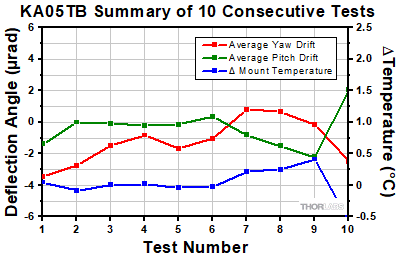
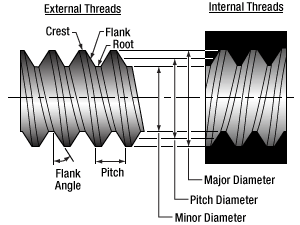

 ズーム
ズーム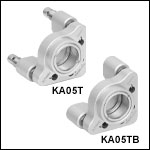
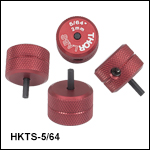
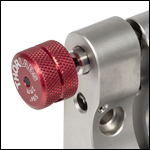
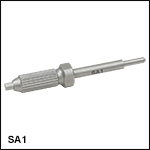

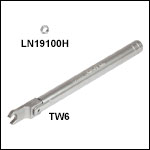
 Ø12.7 mm光学素子用SM05ネジマウント、アルミニウム
Ø12.7 mm光学素子用SM05ネジマウント、アルミニウム